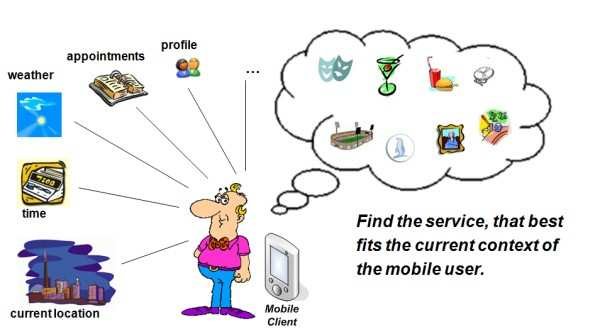Image Source : (PDF) Security in Context-Aware Mobile Business Applications (researchgate.net)
The concept of a Context-Aware Mobile Phone involves designing mobile devices that can dynamically adapt their behavior and services based on the user’s context, which includes factors such as location, environment, user activity, and preferences. This enables a more personalized and relevant user experience. Here are some key aspects and example use cases of a Context-Aware Mobile Phone:
- Location-Based Services:
- Example: A context-aware mobile phone can use GPS data to provide location-specific information such as nearby restaurants, attractions, or events. It can also offer location-based reminders or trigger specific actions when the user arrives at a predefined location (geofencing).
- Proximity Awareness:
- Example: Using Bluetooth or NFC, a context-aware mobile phone can detect nearby devices or objects. This can facilitate tasks like sharing files with a friend in close proximity or unlocking a smart door lock when the phone is near.
- Activity Recognition:
- Example: The phone’s sensors can recognize the user’s activity, such as walking, running, or driving. Based on this context, the device can automatically adjust settings, like activating fitness tracking during a run or enabling hands-free mode while driving.
- Environmental Awareness:
- Example: Sensors on the mobile phone can detect environmental conditions like ambient light, temperature, or noise level. The device can then adjust screen brightness, color temperature, or suggest suitable activities based on the surroundings.
- Time-of-Day Considerations:
- Example: A context-aware mobile phone can adapt its behavior based on the time of day. For instance, it might automatically switch to a “Do Not Disturb” mode during nighttime or suggest morning routines based on the user’s historical patterns.
- User Preferences and Behavior:
- Example: By learning from user behavior, a context-aware mobile phone can anticipate preferences. For example, it may learn when the user usually listens to music and automatically suggest playlists during those times.
- Context-Aware Notifications:
- Example: The phone can prioritize or filter notifications based on the user’s context. For instance, during a meeting, it may mute non-urgent notifications but allow critical ones.
- Augmented Reality (AR) Applications:
- Example: AR apps on a context-aware mobile phone can overlay information on the real world based on the user’s location and surroundings. For instance, historical information about landmarks when the user points the phone’s camera at them.
- Smart Home Integration:
- Example: Interacting with smart home devices based on the user’s location. For instance, adjusting the thermostat when the phone detects the user is heading home.
- Health and Wellness:
- Example: The mobile phone can provide health-related suggestions, such as reminders to take medication or tips for staying active, based on the user’s daily routines and activities.
While context-aware mobile phones offer numerous benefits in terms of user experience and convenience, it’s crucial to address privacy concerns and ensure transparent data usage policies to maintain user trust. As technology advances, these devices can continue to evolve, providing increasingly sophisticated and tailored experiences.
Use of Context Aware Mobile Phone for Teacher and Student
For Students:
- Location-Based Services for Learning:
- Example: A student can receive location-based notifications about educational resources, study groups, or campus events when they are on or near the school campus.
- Classroom Interactivity:
- Example: During lectures, students can use their context-aware mobile phones to interact with in-class activities, quizzes, or polls, adapting the learning experience to their pace and understanding.
- Personalized Study Plans:
- Example: The mobile phone can analyze a student’s study habits and preferences, providing personalized study plans and reminders for assignments or upcoming exams.
- Library Assistance:
- Example: In a library, a context-aware mobile phone can suggest relevant books or resources based on the student’s current courses, academic history, and the section of the library they are in.
- Collaborative Learning:
- Example: Students can use proximity-based features to identify classmates with similar interests or working on similar projects, fostering collaboration and group study sessions.
- Time Management:
- Example: The mobile phone can help students manage their time effectively by sending reminders for classes, assignments, and extracurricular activities based on their schedule.
- Fitness and Well-being:
- Example: Health and fitness tracking features can promote students’ well-being by encouraging breaks, physical activity, and adequate rest during intense study periods.
For Teachers:
- Attendance Tracking:
- Example: Teachers can use context-aware mobile phones to automate attendance tracking based on students’ presence in the classroom using location data.
- Adaptive Teaching Materials:
- Example: Teachers can adjust the learning materials or pace of the lesson based on real-time feedback from students’ interactions with the class through their mobile devices.
- Personalized Feedback:
- Example: Teachers can provide personalized feedback to students by analyzing their engagement, participation, and performance in various learning activities facilitated by mobile devices.
- Classroom Management:
- Example: Mobile phones can be integrated into classroom management systems to automate routine tasks, such as distributing materials or controlling multimedia presentations.
- Remote Teaching Support:
- Example: Context-aware features can assist teachers in adapting to remote teaching conditions, providing tools for effective communication, collaboration, and monitoring student progress.
- Professional Development:
- Example: Teachers can receive context-aware recommendations for professional development opportunities, workshops, or conferences based on their teaching style, interests, and career goals.
- Accessibility Features:
- Example: Context-aware mobile phones can support accessibility features that assist teachers in catering to the diverse needs of students, such as providing real-time translations or adapting content for different learning styles.
- Collaborative Teaching:
- Example: Teachers can use context-aware features to coordinate with other educators, sharing resources, lesson plans, and insights to enhance collaborative teaching efforts.
In summary, context-aware mobile phones can significantly improve the educational experience for both students and teachers by tailoring the learning environment, promoting engagement, and streamlining various aspects of the teaching and learning processes.




